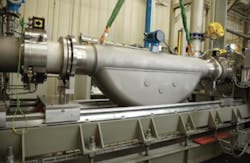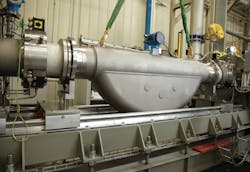Energy and Large-Pipe Applications Drive Coriolis Technology to New Heights
Like other flowmeter categories, growth in the energy markets, especially in oil and gas, is creating opportunities for Coriolis flowmeters. High crude oil prices are a part of this equation. Coriolis flowmeters remain the most accurate flowmeter made, and both accuracy and reliability are critically important for measuring the flow of crude oil and petroleum liquids. While Coriolis flowmeters are used for both upstream and downstream petroleum applications, they are especially suited to downstream petroleum liquids.
The market for Coriolis flowmeters totaled $1.3 billion in 2013, and is projected to grow to almost $2 billion by 2018. Another important force driving the market is the development of large line size Coriolis flowmeters. Coriolis suppliers have shown a readiness to bring out new products to meet new and changing market requirements. This is shown in the development of both straight-tube and large line size Coriolis flowmeters. For many years, nearly all Coriolis flowmeters were used in pipes with diameters of 6” or less. In the past five years, however, four major suppliers have developed Coriolis flowmeters for use with pipes from 8” to 16” in diameter. While these flowmeters can be quite expensive, they are becoming increasingly popular with flowmeter users. Most of these large line size Coriolis flowmeters are designed for custody-transfer applications. Companies that have released these large line size meters include GE Measurement (which acquired Rheonik), Micro Motion (part of Emerson Process Management), Endress+Hauser, and KROHNE.
Coriolis flowmeters have also benefited from industry approvals that previously worked mainly in favor of differentiaL-pressure (DP) and turbine flowmeters. The American Gas Association approved a report on the use of natural gas for custody-transfer applications in 2003, which helps explain the growing use of Coriolis flowmeters for natural gas. The American Petroleum Institute (API) has also issued a draft standard for the use of Coriolis flowmeters to measure hydrocarbon fluids. This document was added to the API Library in July 2012, and the API approved a draft standard called “Measurement of Crude Oil by Coriolis Meters.” While Coriolis flowmeters compete with DP and turbine flowmeters for natural gas applications, they compete with positive-displacement (PD) flowmeters for downstream measurement of petroleum liquids.
READ ALSO:
- Differential Pressure Maintains a Powerful Place in the World of Flow Measurement
- Magmeters Top the Flowmeter Market In Revenue
- PD Flowmeters Poised to Gain from Oil & Gas Application Opportunities
- Emissions Monitoring Applications Propel Thermal Flowmeter Market
- Turbine Flowmeters Remain Competitive in Turbulent Market
- Custody-Transfer Applications Drive Ultrasonic Flowmeter Growth
- Vortex Flowmeters Prove Their Worth In Steam Flow Measurement
Even though Coriolis flowmeters are being used more widely to measure both natural gas and industrial gases, liquids still account for more than 75 percent of Coriolis flow applications. Liquids are denser than gas, and Coriolis flowmeters rely on the momentum of the fluid as it travels through the meter to generate the flow measurement. And even though measurement of the flow of petroleum liquids is growing at a faster rate than measurement of non-petroleum liquids, measurement of non-petroleum liquids still represents a larger segment of the fluid measurement market.
Coriolis flowmeters remain somewhat expensive, but the twin benefits of high accuracy and long-term reliability outweigh the upfront purchase price for many flowmeter users.
To read more about Flow Research’s work in the area of Coriolis flow measurement, visit www.flowcoriolis.com.
Jesse Yoder
Jesse Yoder, Ph.D., is president of Flow Research Inc. He has 30 years of experience as an analyst and writer in instrumentation. Yoder holds two U.S. patents on a dual-tube meter design and is the author of "The Tao of Measurement," published by ISA. He may be reached at [email protected]. Find more information on the latest study from Flow Research, "The World Market for Gas Flow Measurement, 4th Edition," at www.gasflows.com.



